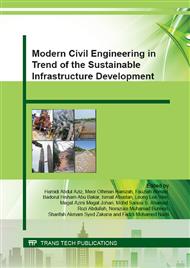[1]
S. Donatello, A. Palomo, & A. Fernández-Jiménez, Durability of very high volume fly ash cement pastes and mortars in aggressive solutions. Cement and Concrete Composites, 38 (2013) 12-20.
DOI: 10.1016/j.cemconcomp.2013.03.001
Google Scholar
[2]
M. Kawamura, & K. Takeuchi (1996). Alkali-silica reaction and pore solution composition in mortars in seawater. Cement and Concrete Research, 26(12), 1809-1819.
DOI: 10.1016/s0008-8846(96)00178-0
Google Scholar
[3]
R. De Gutierrez, S. Delvasto & R. Talero, Permeability properties of cement mortars blended with silica fume, fly ash, and blast furnace slag. Marine Corrosion in Tropical Environments, ASTM STP 1399 (2000).
DOI: 10.1520/stp13562s
Google Scholar
[4]
A.M. Neville, Cementitious materials of different types. Properties of concrete (5th ed., pp.83-87). London: Pearson Education Limited, (2011).
Google Scholar
[5]
B. Ma, X. Wen, M. Wang, J. Yan, & X. Gao, Drying shrinkage of cement-based materials under conditions of constant temperature and varying humidity. Journal of China University of Mining & Technology, (2007) 17(3), 428-431.
DOI: 10.1016/s1006-1266(07)60119-9
Google Scholar
[6]
T.U. Mohammed, H. Hamada, & T. Yamaji, Performance of seawater mixed concrete in the tidal environment. Cement and Concrete Research, (2004) 34(4), 593-601.
DOI: 10.1016/j.cemconres.2003.09.020
Google Scholar
[7]
B. Rai, S. Kumar, & K. Satish, Effect of Fly Ash on Mortar Mixes with Quarry Dust as Fine Aggregate. Advances in Materials Science and Engineering, (2014) 1-7.
DOI: 10.1155/2014/626425
Google Scholar
[8]
N. Winter, N. (2009, December 1). Cement hydration. Retrieved April 9, 2015, from http: /www. understanding-cement. com/hydration. html.
Google Scholar
[9]
H. U, Jensen, The effect of sea-water on the hydration of cement and fly- ash cement blends. PhD Thesis, University of London, (1987).
Google Scholar
[10]
R.K. Dhir, & M.R. Jones, Development of Chloride–Resisting Concrete Using Fly Ash, Fuel, Vol. 78, No. 2 (1999), pp.137-142.
DOI: 10.1016/s0016-2361(98)00149-5
Google Scholar
[11]
ASTM Standard C109, n. d. Standard Test Method for Compressive Strength of Hydraulic-Cement Mortars (Using 2-in or [50mm] Cube Specimen), ASTM International, West Conshohocken, PA, 2003, DOI: 10. 1520/C0109_C0109M-05, www. astm. org.
DOI: 10.1520/c0109_c0109m-21
Google Scholar
[12]
ASTM Standard C157 M-99, n. d. Standard Test Method for Length Change of Hardened Hydraulic-Cement Mortar and Concrete, ASTM International, West Conshohocken, PA, 2003, DOI: 10. 1520/C0157_C0157M-08E01, www. astm. org.
Google Scholar
[13]
Institute of Specialist Surveyors and Engineers on Suphate attacks (2011), http: /www. isse. org. uk.
Google Scholar
[14]
CEMEX United States (2015), http: /www. cemexusa. com.
Google Scholar
[15]
N. Baker, & P. Banfill, The use of admixtures in high alumina cement mortar for the marine environment. 9th International Congress on Chemistry of Cement, IV (1992), 719-725.
Google Scholar
[16]
D. Furuya, N. Otsuki, T. Saito, & L.Y. Sub, A Study on the Effects of Seawater as Mixing water on the Hydration Characteristics of Blast – Furnace Slag Cement. 34th Conference on OUR WORLD IN CONCRETE & STRUCTURES, 100034012 (2009), 1-7.
Google Scholar


